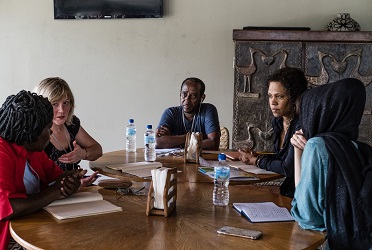by Amy Czajkowski and Charles Gibbs
An Overview and Invitation
At a time when people and systems seem overmatched by the size and urgency of the challenges we face, what worked for yesterday’s problems won’t solve today’s and won’t help us create the world we’d like to inhabit tomorrow. In the absence of a shared vision of a whole, healthy system with enlivened, mutually enriching partnerships at all levels, we teeter between seemingly oppositional forces that pit individual good against the good of community and national interests against global interests, as if we have to choose one or the other.

(c) Tom Saater and Catalyst for Peace
So how do we work in ways that meet the needs of now and also build toward a resilient, regenerative, inclusive and sustainable future? That come up with actionable answers that create change for the good of the whole rather than one “side” or another? Today we launch a four part-blog series exploring the learning and design spaces that lead to positive change in our communities and organizations, as we have been working to create them.
In this series, the authors draw on CFP’s experience with Fambul Tok in Sierra Leone, and on Charles’ experience as the founding executive director of United Religions Initiative and Amy’s experience as director of Coming to the Table, initiatives that invited diverse and sometimes divided perspectives into the same space to imagine a better future while facing some of today’s most difficult challenges – the harms of war, religiously-motivated divisions and violence, and addressing racism and discrimination both on a personal and societal level.
This blog series outlines some of the dimensions that we have found critical to creating learning spaces where participants can live into the new together as we identify relevant answers to current challenges and celebrate breakthroughs. We say “learning” space not to signal a place of formal education or training but a space that invites knowledge, experience, wisdom and nuggets of insight from even the most painful experiences to address today’s questions and needs so we can create the new together. We are assuming that no one person has THE answers, but that together we can learn and design our way into the future we desire.
This month, in partnership with the Institute for State Effectiveness (ISE), CFP launched the Learning Exchange for Community-Centered Peace & Development initiative, an ongoing series of virtual convenings for practitioners working on peace and development. In these virtual convenings, we are inviting everyone’s experience into growing whole, healthy systems by grappling with how to reorient and transform practices of funders, international and national organizations and governments to make space for community ownership and leadership in peace and development. And we hope to demonstrate the principles we are describing in this blog series in the Learning Exchange. Although, in our work we are directly engaging people concerned with peace and development, we believe the learning and design spaces we are describing apply to a broad range of endeavors.
In the course of this blog series, we will explore the following dimensions of learning and design spaces:
- Creating the Container: The Importance of Being Intentional
- Slowing Down and Listening
- Inclusion – Who’s in the Space –
- Welcoming Whole People Including Pain and Hard Things
- Emergence – Responding to Now
- Consistency and Follow-through – Following the Conversation, Naming and Moving to Action
We invite your comments and questions to help enrich and deepen this ongoing exploration of new possibilities.

